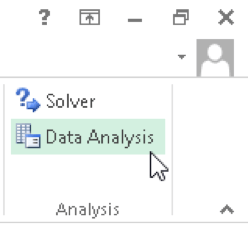So, you can ask your team to join in and share their inputs. And you feel that you need the help of your team in creating something worthwhile. How to do a hard return in google sheets for mac.
At the bottom of the window select Excel Add-ins from the drop-down to the right of Manage:, click Go to proceed. The Add-Ins window will open, add a checkmark to the check box next to Analysis ToolPak, click OK. Once enabled the Data Analysis ToolPak will be. The Analysis ToolPak is one of Excel’s most beloved ‘Application Add-ins’. And for a good reason! This add-in, with its financial, statistical, and engineering data analysis tools, can save you a great deal of time. All you have to do is simple: provide the data and parameters and let the appropriate tools do the work. Excel Analysis Toolpak for Mac. If your a student such as myself and use a Mac, you have probably run into a few complications in certain course work. To save you sometime researching your different options, I have found a few different ways you can access the Excel Analysis Toolpak on your Mac.
Yes, it appears to have been discontinued. Refer to the discussion at What happened to the Data Analysis Toolpak or Solver in Excel for Mac 2011? – answers.microsoft.com.Quote: The Data Analysis Toolpak was removed in Office for Mac 2008. Installing the Analysis ToolPak on Mac. Select Tools at the top of your screen and choose “Add-ins” from the dropdown menu. Check the Analysis ToolPak and click OK 9. Excel will install the Analysis ToolPak automatically, and you can locate it by clicking the Data tab.
Microsoft’s spreadsheet application known as Excel, found in Microsoft Office, features graphing tools, calculation capabilities, pivot tables and many other helpful tools for its users. In addition to these default features, the user may choose to incorporate various add-ins offered by Microsoft at no cost. The add-in we are discussing today is the Analysis ToolPak which performs complex statistical and engineering analyses.
This particular Excel add-in is easy to install and use and saves the user time in performing complex analyses. Because these functions are quite complex and not needed by the average Excel user, they are not found in the default version of the program and it is necessary for the user to add them on his or herself.
Excel’s Data Analysis ToolPak for Mac is easy to install:
- Click the “Tools” tab at the top of the screen while in Excel.
- Then click “Add-Ins”
- Finally, check the box that says “Analysis ToolPak” then “OK”
The program will then take a few seconds to add this feature to Excel. After it is done loading, the user can access the Data Analysis ToolPak by clicking the “Tools” tab again at the top of the screen and then clicking “Data Analysis”, which now appears at the bottom of this pull-down menu.
After accessing Data Analysis, a box pops up with the various analysis tools. The next section will describe the various tools that the Data Analysis ToolPak has to offer.
Functions of the Analysis ToolPak
There are 19 different functions found within this feature. We won’t get into every one, as a few of them are subsets of more general functions.
- The Anovaanalysis tools (single factor, two-factor with replication, two-factor without replication) provide different types of variance analysis. Anova is used to see if there is any difference between groups of some variable.
- The Correlation worksheet calculates the correlation coefficient between two measurement variables when measurements on each variable are observed for each of N subjects. This tool examines a pair or measurement variables and determines whether they tend to move together, or correlate.
- The Covariance tool can be used in the same setting as Correlation when you have N different measurement variables observed on a set of individuals, and like Correlation, it will give you an output table (matrix) that illustrates the covariance between the two variables.
- The Descriptive Statistics tool generates a report of univariate statistics for data in the input range, providing information about the central tendency and variability of the data.
- Exponential Smoothing predicts a value that is based on the forecast for the prior period, adjusted for the error in that prior forecast. It uses the smoothing constant a, the magnitude of which determines how strongly the forecasts respond to errors in the prior forecast.
- The F-Test Two-Sample for Variances analysis tool performs a two-sample F-test to compare two population variances.
- The Fourier Analysis tool solves problems in linear systems and analyzes periodic data by using the Fast Fourier Transform (FFT) method to transform data.
- The Histogram analysis tool calculates individual and cumulative frequencies for a cell range of data and data bins. This tool generates data for the number of occurrences of a value in a data set.
- The Moving Average analysis tool projects values in a forecast period, based on the average value of the variable over a specific number of preceding periods. A moving average provides trend information that a simple average of all historical data would mask. This tool might be used to forecast sales, inventory, or other trends. Each forecast value is based on the following formula.
- The Random Number Generation analysis tool fills a range with independent random numbers that are drawn from one of several distributions and you can characterize the subjects in a population with a probability distribution.
- The Rank and Percentile analysis tool produces a table that contains the ordinal and percentage rank of each value in a data set. You can analyze the relative standing of values in a data set.
- The Regression analysis tool performs linear regression analysis by using the “least squares” method to fit a line through a set of observations. You can analyze how a single dependent variable is affected by the values of one or more independent variables.
- The Sampling analysis tool creates a sample from a population by treating the input range as a population. When the population is too large to process or chart, you can use a representative sample. You can also create a sample that contains only the values from a particular part of a cycle if you believe that the input data is periodic.
- The t-Test analysis tools test for equality of the population means that underlie each sample. The three sub features of this tool (paired two sample for means, two-sample assuming equal variances, two-sample assuming unequal variances) employ different assumptions: that the population variances are equal, that the population variances are not equal, and that the two samples represent before-treatment and after-treatment observations on the same subjects.
- Finally, the z-Test tool performs a two sample z-Test for means with known variances. This tool is used to test the null hypothesis that there is no difference between two population means against either one-sided or two-sided alternative hypotheses.
What do These Tools Look Like in Use?
Here’s a few screenshots to show some of these handy tools in action.
Above is an example of how the Anova feature would work.
And this is the correlation function in use.
Finally, we have the rank and percentile tool pictured. Here, a teacher has put her students’ grades into the program and their grade (percentile) has been calculated from the data given.
While MS Excel for Mac can be utilized very effectively for relatively simple tasks, it can also perform very specific, complex analysis functions with the Data Analysis ToolPak add-in. Depending on how you need to analyze certain data and variables, Excel can accommodate even the most demanding users such as engineers, statisticians and business owners, among many others.
Related articles:
The Analysis ToolPak is an Excel 2007 add-in program that adds extra financial, statistical, and engineering functions to Excel’s pool of built-in functions. The tools included in the Analysis ToolPak enable you to analyze worksheet data by using such things as ANOVA, F-Test, rank and percentile, t-Test, and Fourier analysis.
Although the Analysis ToolPak comes with EXcel 2007, it doesn’t come pre-installed. Before you can use the statistical functions added by the Analysis ToolPak, you must install and load it as follows:
1Click the Office button and then click the Excel Options button.

The Excel Options dialog box opens.
2Click the Add-Ins tab in the left pane.
The Add-Ins tab contains a list of all the add-in programs installed on your computer.
3Select Excel Add-Ins from the Manage drop-down list (at the bottom) and click Go.
Excel opens the Add-Ins dialog box.
4Select the Analysis ToolPak check box in the Add-Ins dialog box and then click the OK button.
You might find some other interesting add-ins there, too.
5If an alert dialog box asking you if you want to install the add-in appears, click Yes.
Because add-ins often contain macros, and macros can open up your computer to malicious attacks, Microsoft has raised security level surrounding add-ins.
If you need to develop complex statistical or engineering analyses, you can save steps and time by using the Analysis ToolPak. You provide the data and parameters for each analysis, and the tool uses the appropriate statistical or engineering macro functions to calculate and display the results in an output table. Some tools generate charts in addition to output tables.
The data analysis functions can be used on only one worksheet at a time. When you perform data analysis on grouped worksheets, results will appear on the first worksheet and empty formatted tables will appear on the remaining worksheets. To perform data analysis on the remainder of the worksheets, recalculate the analysis tool for each worksheet.
Data Analysis Toolpak For Mac
Windows
Follow these steps to load the Analysis ToolPak in Excel 2016 for Mac:
Analysis Toolpak Vba Excel Mac

- Click the File tab, click Options, and then click the Add-Ins category.
- In the Manage box, select Excel Add-ins and then click Go.
- In the Add-Ins box, check the Analysis ToolPak check box, and then click OK.
- If Analysis ToolPak is not listed in the Add-Ins available box, click Browse to locate it.
- If you are prompted that the Analysis ToolPak is not currently installed on your computer, click Yes to install it.
- If Analysis ToolPak is not listed in the Add-Ins available box, click Browse to locate it.
macOS
Follow these steps to load the Analysis ToolPak in Excel 2016 for Mac:
- Click the Tools menu, and then click Excel Add-ins.
- In the Add-Ins available box, select the Analysis ToolPak check box, and then click OK.
- If Analysis ToolPak is not listed in the Add-Ins available box, click Browse to locate it.
- If you get a prompt that the Analysis ToolPak is not currently installed on your computer, click Yes to install it.
- Quit and restart Excel.
- Now the Data Analysis command is available on the Data tab.
- If you get a prompt that the Analysis ToolPak is not currently installed on your computer, click Yes to install it.

Lesley University provides Microsoft Office for free to all enrolled students. You can find written Instructions here and a video walk-through here.
 Therefore, they cannot be installed and activated after upgrading to macOS Catalina.
Therefore, they cannot be installed and activated after upgrading to macOS Catalina.
For additional support, please contact Microsoft Office Support. Banktivity for mac reviews.
